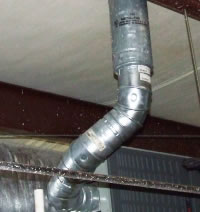Propane Gas Appliance Ventilation

Gas appliance venting is the process of removing products of combustion out of a structure to the outside atmosphere. Certain appliances installed inside a home require venting, such as gas powered furnaces and hot water heaters. Some gas appliances do not require venting and are listed as such provided the appliance installation is within the scope of NFPA 54 requirements as well as according to the manufacturers recommendations for proper placement and use.
Gas appliances subject to venting are required to utilize approved vent materials as well as installation procedures according to NFPA 54. Improper vent installation or the absence of venting when required can lead to extremely hazardous conditions within a home or building.
Gas Appliance Venting Purpose
Appliances requiring ventilation are listed as such by the manufacturer and are subject to venting rules as written in NFPA 54. Although propane is a clean burning gas, appliances meeting or exceeding specified BTU ratings are subject to exhaust ventilation requirements for health and safety reasons. Not only is the venting of certain appliances a protective concern and requirement but the removal process of flue gases itself is also a subject requiring care and planning. The absence of ventilation, improper materials and/or incorrect installation of the venting can result in Carbon Monoxide poisoning. Damage to venting can occur if the combustion of LP Gas is incomplete as well. Do not attempt to install, modify or repair ventilation equipment without consulting the appliance manufacturer, licensed HVAC professional or your propane company.
Approved Propane Exhaust Venting Materials
The materials used for venting differ among listed appliances and approved venting materials are set out by the appliance manufacturer. Different appliances produce flue gases of varying temperatures and quantities and because of these factors, appliances are subject to using venting materials approved by the equipment manufacturer. The most common materials that are used to ventilate flue gases in propane systems include single walled metal duct pipe and double walled vent pipe. Unapproved and illegal LP Gas appliance venting materials include PVC pipe and HVAC air ducting and are extremely dangerous if installed to vent flue gases to the outside atmosphere.
Propane Appliance Venting Design and Installation
Appliance venting and duct installation should be handled by licensed professionals. If multiple appliances are connected to or share a common ventilation pipe, special considerations must be made. Did you know that ventilation pipe must be properly sized similar to that of LP Gas pipe sizing? Vent pipe that is too small in diameter will not adequately exhaust flue gases to the outside atmosphere. It can act as a bottleneck and function to restrict toxic gas venting. Appliances generating low-heat flue gases are held to strict venting standards to ensure the heat generated by exhaust will be sufficient to push the gases all the way out of the vent system (heat rises). Some appliances will require an exhaust fan to properly vent flue gases while others may not. The planning and installation of a ventilation system is a serious issue in the LP Gas industry as almost 25% of all propane related fatalities are due to Carbon Monoxide poisoning. If you are concerned about the condition of your gas appliance ventilation system or if you need assurance that it has been installed properly contact your city code compliance department, your propane company, a building (home) inspector or an HVAC company.
Installing exhaust ventilation incorrectly can result in unsafe circumstances as well as damage to property and/or the propane appliance. Installation of venting must be as directed by the appliance manufacturer. For instance, the approved joining methods for LP Gas venting pipe do not include duct tape or industrial adhesives. Always consult a professional before attempting to diagnose or repair an existing vent system.
